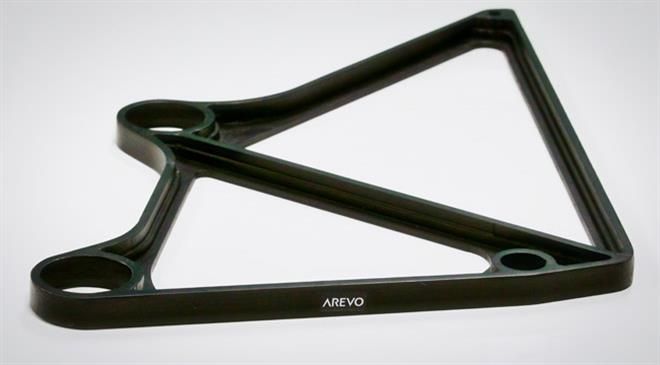TT: What is Arevo all about? What does your company specialise in?
Arevo was founded to transform composite manufacturing through 3D printing framework (digitalisation) with breakthrough advancements in algorithms, materials, process and robotics-based automation. Digitalisation has transformed many industries in recent years, e.g, brick and mortar-based shopping, music, personal vehicular transportation and financial transactions. Supply chain and manufacturing are next.
Arevo DNA technology is unique in the additive manufacturing (AM) world as it features patented software algorithms enabling generative design techniques, free-motion robotics for 'true 3D' construction, and Laser-based direct energy deposition for virtually void free construction, all optimised for anisotropic composite materials.
TT: Can you tell us more about your 6-axis 3D printing platform?
Conventional 3D printers typically print in 2D on stacked horizontal planes. By making all axes available, our robotic arm in conjunction with software algorithms removes design constraints, enables true 3D printing, and provides the freedom to create. Traditional 3D printers use a 3-axis Cartesian gantry, which deposits material layer by layer on an XY horizontal plane (similar to paper printing). It is more like 2.5D printing, not true 3D.
When we started Arevo, we set out to print a 3D surface rather than a two-dimensional plane. The main advantage we saw was to improve the strength in the Z-axis direction. It was a challenge because we had to reinvent the software and find multi-axis machines for 3D surface printing. We turned to a ready-to-use multi-axis robotic arm to achieve what we now call free-motion deposition.
TT: How does your direct energy deposition (DED) process that uses laser heating lead to a 100-fold increase in production speed? How is it better than traditional methods?
With Arevo DED, instead of a heated nozzle that is typically used in material extrusion processes, a laser is adopted to provide rapid heating, which makes it a 'direct energy' process. A compaction roller compresses the filaments with sufficient pressure to eliminate the voids inside and in between layers, and consolidates the parts in-situ. Detailed studies of the characteristic control of the deposition system were conducted to tailor the optimum process parameters for any given material and geometrical features, to obtain good inter-layer adhesion and consolidation. This moves the technology from prototyping to manufacturing.
The 100X improvement factor results from the fact that the Arevo DED process combines the advantages of additive manufacturing like bridging (without support structure), overhangs and in particular, load path optimised fibre path, with in-situ consolidation of high performance light-weight composite structures without additional post consolidation or curing. This provides tremendous benefits for the manufacturing of a large variety of engineering structural parts, and finally brings the value of AM to manufacturing at scale.

TT: What are the various applications of 3D printed composites?
Combining continuous carbon fibre-based thermoplastics with our unique DED process in conjunction with our generative design, fibre orientation optimisation and predictive analysis algorithms allows the creation of light-weight and ultra-rugged structures with geometry that was impossible to obtain until now. Replacing metal alloys with carbon fibre thermoplastics is desirable in terms of increased strength and resilience and lower production costs. Further, our DED process enables complex features only possible with AM technologies. Among these features are hollow sections like the box beams, thin, curved walls as well as overhangs, which were recently showcased in a 3D printed bike frame.
Therefore, we see most applications currently in the transportation, aerospace and construction industries. But we are not specifically looking at one particular industry application; we believe the technology has broad applications across many industries.
TT: What products do you mass-produce as on date?
Arevo DNA is now enabling the 'serial' production of additive manufactured composite parts. For example, an aircraft seat bracket is currently an assembly of four metal parts supporting the seat at the bottom. Arevo generative software created a single composite part, which used the least amount of material with perfect fibre orientation in 3D space while meeting the required performance specifications. It is also important to point out that this technology can be applied to manufacture customised consumer products. For example, each one of the potential 200,000 bike frames can be unique with different designs and sizes.
TT: How did you apply carbon fibres in novel ways to 3D print bikes and what was the outcome?
The unibody bike frame construction enabled by Arevo technology is based on industry-first advances in free motion robotics and software that enable 'true 3D' printing. The Arevo frame is made as a single part in contrast to current composite frames, which are made of many parts glued together. With Arevo's intelligent continuous carbon fibre placement, unprecedented structural integrity and stability are achieved.
Further, the Arevo DNA AM process takes the design and final manufacture of a bike frame from 18 months to just a few days at a significant reduction in product development costs.

TT: What are some of the other complex geometric shapes that you want to 3D print in future?
As noted above, the sky is the limit practically when it comes to true 3D printing and we look forward to discussing structural requirements with customers and partners in a wide range of industries, which could very well result in new shapes and parts that have been heretofore unimaginable.
TT: What do you use for 3D printing of composites-thermosetting or thermoplastics polymer-and why?
We use thermoplastics. As compared to the thermoset (TS) material dominantly used today, continuous fibre reinforced thermoplastics (CFRTP) is a recyclable material that doesn't have a limited shelf life and doesn't require refrigeration for storage. It doesn't require secondary curing operation in an oven, which is energy intensive. All these mean a more sustainable, efficient and cost-effective production. Furthermore, from an engineering performance point of view, thermoplastics (TP) are tougher and not as brittle. So, in an impact, TP will perform a lot better than TS.
TT: Which are the sectors you are targeting for future projects?
When it comes to 3D printing with composite materials, the greatest impact in the near future will be in the area of creating structural parts for a wide variety of purposes, e.g, bike frames, flying taxi (eVTOL), airplane seat frames and other airplane primary structures, automotive suspension arms and even crash structures.
TT: Which are your current markets around the world? Who are your major clients?
As noted above, most applications are currently in the transportation, aerospace and construction industries. We have announced deals of various types with industry leaders and a leading innovator in the bike industry.
TT: Who are your biggest competitors? What differentiates you from them?
In AM or 3D Printing, there are a number of solutions primarily driven by the fused deposition modelling (FDM) technology invented by Stratasys, but now a number of other players offer it. There is new technology from companies such as HP, Carbon and FormLabs that compete with FDM technology.
However, in AM-made ultra-strong and light-weight composite components replacing metal parts, there aren't many solutions. This is what Arevo is pioneering. We create structures from composite materials using fibres and thermoplastic polymers that have enough strength to replace metal parts.
We have already begun production of composite unibody, bicycle frames. This is a good example as the majority of frames shipped today are metal, whether aluminum or titanium; there are even composite bike frames made with 27-28 parts glued together. It is a manual and messy process. Arevo DNA technology allows these products to be manufactured in a fully automated way, as a single part.
TT: How has the series B funding round led by Asahi Glass boosted your company's growth?
The series B funding was critical to help us expand our business opportunities, as seen in the recent announcements with Franco Bicycles and Airbus, and the opening of our new production facility in Milpitas.
TT: You have 55 patents issued till date. Which are the major research and development (R&D) works you are focusing on at the moment?
The phrase 'continuous improvement' is used throughout the world of manufacturing and it certainly applies to Arevo's R&D going forward. When thinking of our DED process, for instance, we will seek to improve upon our already industry-standard setting achievements in such areas as: reliable designs for the service life of these end-use components; the acceleration of a design process that has decreased in some areas from months to days; further cost reductions in areas such as tooling and materials processing and enhancements in software engineering that will create even more 'customisation' options.
TT: What are the long-term sustainability goals set by your company?
The Arevo DNA AM process definitely fits in the category of 'lean and green' as it results in significant decreases in power consumption, transportation, fuel consumption throughout the supply chain network and materials waste (using materials more efficiently and using recyclable materials).
TT: What new is on the anvil?
We will have new product introductions and announce new customers or partners at leading events such as Eurobike in Germany in early September.





